Visit Krakow to experience a magical city where horse-pulled carriages make their way through cobbled streets, leading to spectacular squares filled with stunning cathedrals.
If cathedrals, castles and some of the best bars and cafe in Europe are not enough to convince you to visit, you can also spend a day in a salt mine and see an underground cathedral made entirely out of salt, visit the infamous Auschwitz-Birkenau death camp or hop on a tram and visit one of only two socialist-realist districts ever built.
Whatever your interests, you will find that Krakow has you covered. It is a truly wonderful city that you can keep re-visiting and never tire of its charm. It is not surprising that it has been voted the best city break in Europe three years in a row.
Things To Do In Krakow
Auschwitz-Birkenau Memorial And Museum
Heroes’ Square
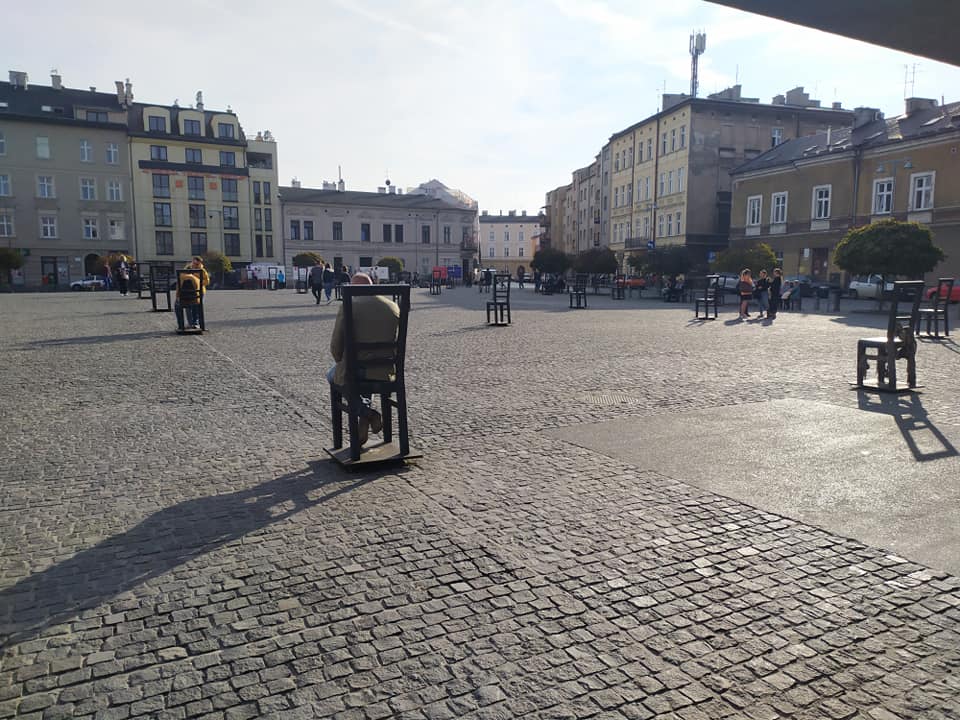
Ghetto Heroes’ Square
This memorial to the Jewish victims of Krakow during the Holocaust is located in the main square of the former Jewish ghetto (map). Each chair represents approximately 1000 Jews that lived in Krakow before WWII. There are 70 chairs. Only 6000 Jews survived.
At one of the corners of the square, there is a small museum called ‘Apteka pod Orłem’ (map). This museum is in Tadeusz Pankiewicz’s former pharmacy. Tadeusz refused to move out of the ghetto, as ordered by the Nazis. He claimed he could be useful in the ghetto so they let him stay. Horrified by what he saw, he began to help Jews. If you are struggling to get tickets for the Schindler Museum, you can buy a double ticket for this museum and Schindler Museum and guarantee entrance.
Historical Museum of Krakow, Pomorska Street
The Historical Museum Of Krakow, Pomorska Street is a small but well-presented museum in the former Gestapo prison for political opponents. It commemorates those that fought against both the Nazis and the Stalin totalitarianism that followed WWII. Make sure you visit the prison cells that were used in WWII. Map.
Click here for details on opening times and tickets.
Kazimierz
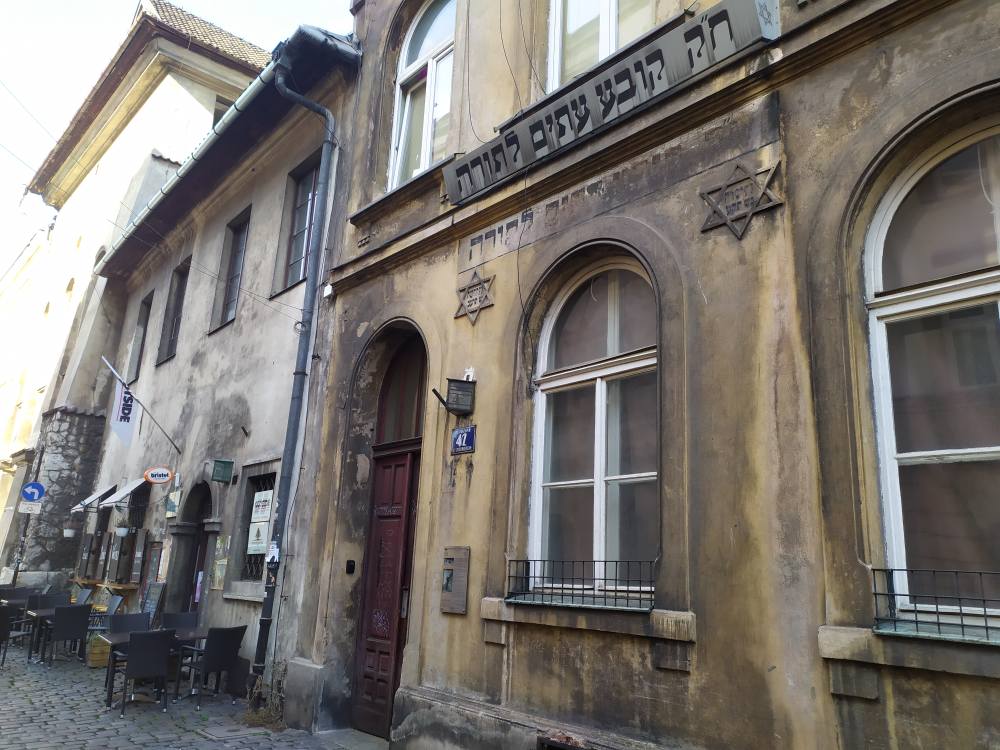
Kazimierz
‘Kazimierz’ (map) is the historic Jewish quarter of Krakow. Whilst the Jewish influence is still strong, it is now filled with quirky boutique shops, art galleries, street food and hip bars. You’re also less likely to run into any stag crowds in this area (they seem to stay around the main square). Come here to enjoy the wonderful bars, eat zapiekanka or take a free walking tour to discover the Jewish history in the area.
Krakow Free Walking Tours
One of the best ways to get about the city and view its most interesting sights is by taking a walking tour. There are a number of paid tour options but I used a free walking tour company called ‘Free Walkative Tours’. They work on a tip-based scheme so they have an incentive to be really good. Tips are optional and you won’t feel pressured into giving anything at all.
My first tour was around Kazimierz on the ‘Jewish Walking Tour‘. Our guide was very informative and friendly. He used to live in the area so he had insider knowledge. We learnt about the Jewish history, the synagogues and walked the streets where Schindler’s List was filmed. He filled the history with individual recounts and stories which made it more interesting. It really was an excellent tour.
The second tour I attended was the ‘Ghetto Walking Tour‘. The tour began in Kazimierz and took us over Lover’s Bridge to the perimeter of the former Jewish ghetto.
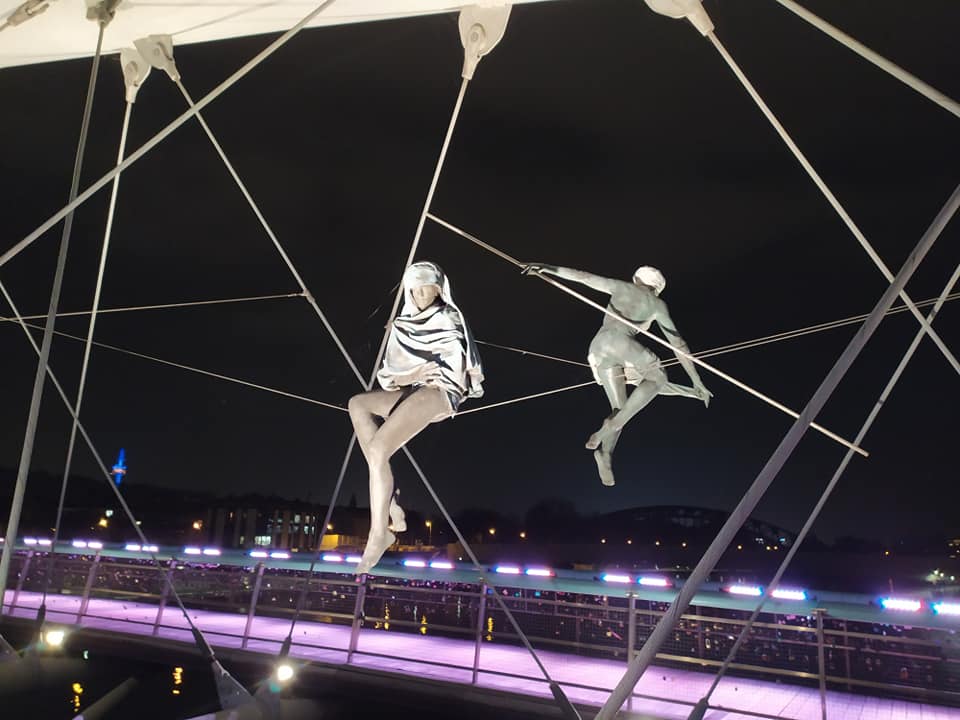
Lovers’ Bridge
Just outside the ghetto is Église Saint-Joseph Church. It’s almost unbelievable to think that people used to visit the church just metres away from where people were living in unspeakable conditions.
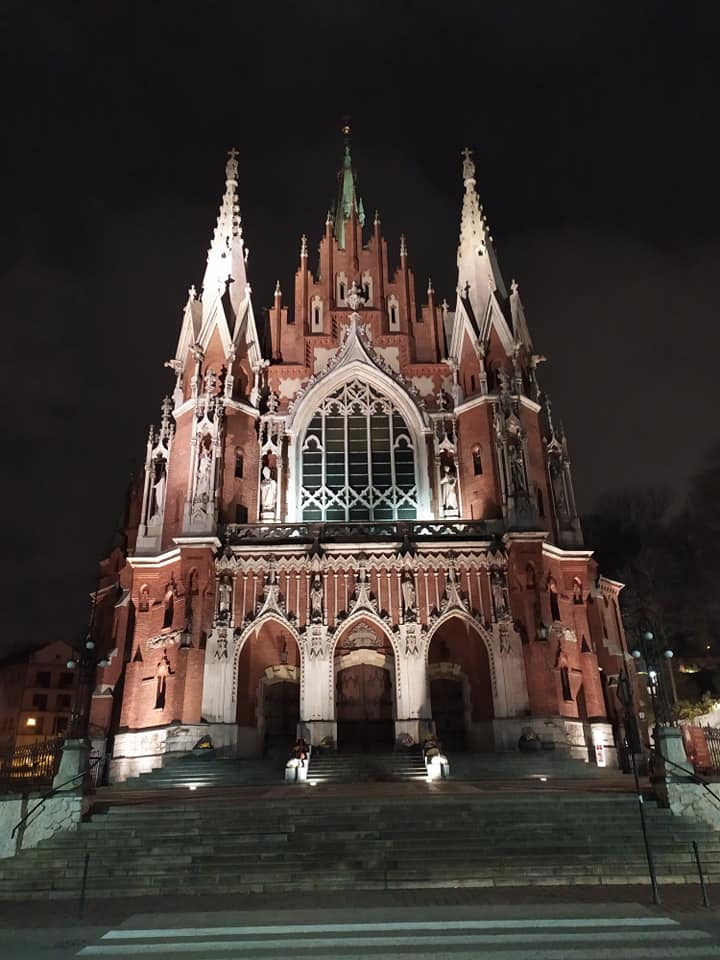
Église Saint-Joseph Church
Just to the left of the church was the ghetto wall. Part of the wall was made up of houses where the windows were bricked up. One young boy who was living there during the time of the ghetto escaped and left for the country where he pretended to be a Christian orphan. He survived the war. His name was Roman Polanski.
We moved through the ghetto, stopping at old synagogues and other places of interest. The tour led us to the Ghetto Heroes Square and then to Schindler’s factory.
You can book a tour through Free Walkative Tours at their website https://freewalkingtour.com/krakow/.
MOCAK (Museum of Contemporary Art Krakow)
‘MOCAK’ (map) is located behind the Schindler factory. In fact, it is based in the actual factory where the Schindler Jews worked. The Schindler factory is based in the administration offices of the factory. There are many exhibitions throughout the year. We were unfortunate to visit in between exhibitions so a lot of the museum was closed. The entrance fee was reduced accordingly and we still got to see some anti-Jewish propaganda from the 1940s and some contemporary art.
MOCAK Opening Times: 11 am – 7 pm, Tues – Thu & Sat – Sun. 11 am – 8 pm, Fri.
MOCAK Entrance Fee: 14 PLN.
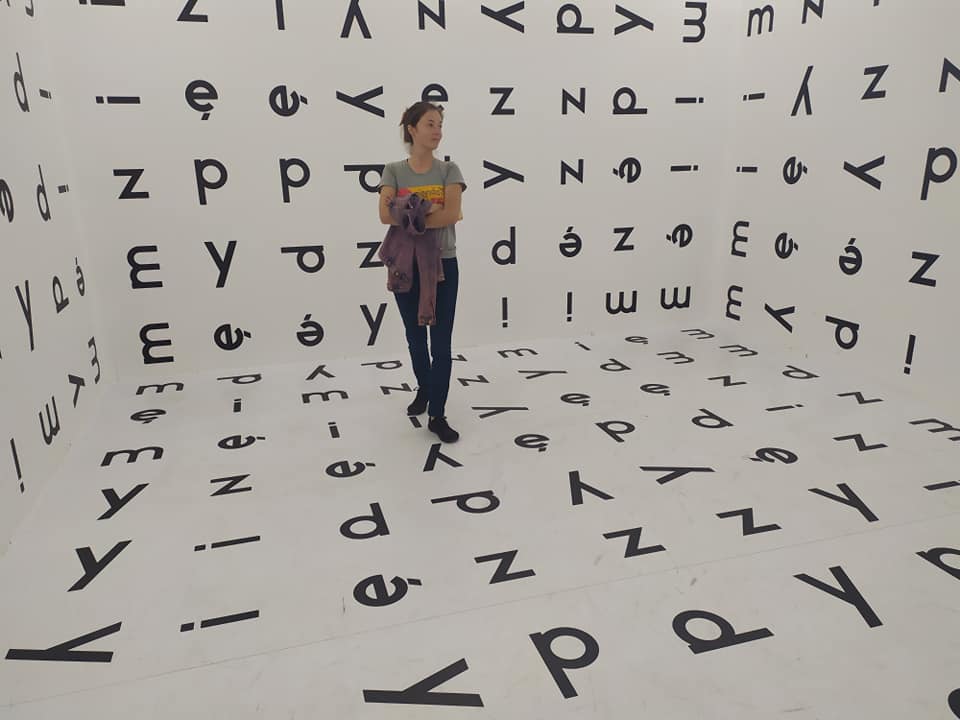
MOCAK
Nova Huta
Oskar Schindler’s Enamel Factory
The movie ‘Schindler’s List’ did wonders to Krakow’s tourism. Before the film, Kazimierz Jewish district was run-down and home to many ex-criminals. It was not a place to be after dark.
Nowadays, people come to learn about the history of Krakow during WWII and the Jewish district, Jewish ghetto, Auschwitz and Schindler’s factory are all popular destinations. So much so that these days you have to book tickets in advance and for specified times. Don’t expect to just turn up and guarantee entry.
The museum itself is not a Schindler museum. In fact, only a small part is dedicated to the man who saved many Jews from murder at the hands of the Nazis. It is a museum of Krakow during Nazi occupation. There are many interactive elements to the museum and there are permanent and temporary exhibitions. If you are interested in this dark period of history, then you must definitely visit. Map.
Oskar Schindler’s Enamel Factory Opening Times:
November – March
Mon: 10 am – 2 pm
Tue – Sun: 10 am – 6 pm
April – October
Mon: 10 am – 4 pm (every first Monday of the month: open to 2 pm)
Tue – Sun: 9 am – 8 pm
Last admission is 90 minutes before closing time.
For more info: https://www.muzeumkrakowa.pl/branches/oskar-schindlers-factory
Plaszow Concentration Camp
Not as well known as Auschwitz, but the events that took place here were no less horrific. Though there were no gas chambers here, mass killings did take place by shooting.
Situated in the south of the city, Plaszow, unlike Auschwitz, was almost entirely destroyed by the Germans as the red army approached. All the buildings were destroyed and the bodies from the mass graves were exhumed and burnt. The camp commandant, Amon Goth, was known for his sadistic treatment of the prisoners. It was said that he could not have breakfast without shooting at least one person. His character and the camp are featured in the film ‘Schindler’s List.
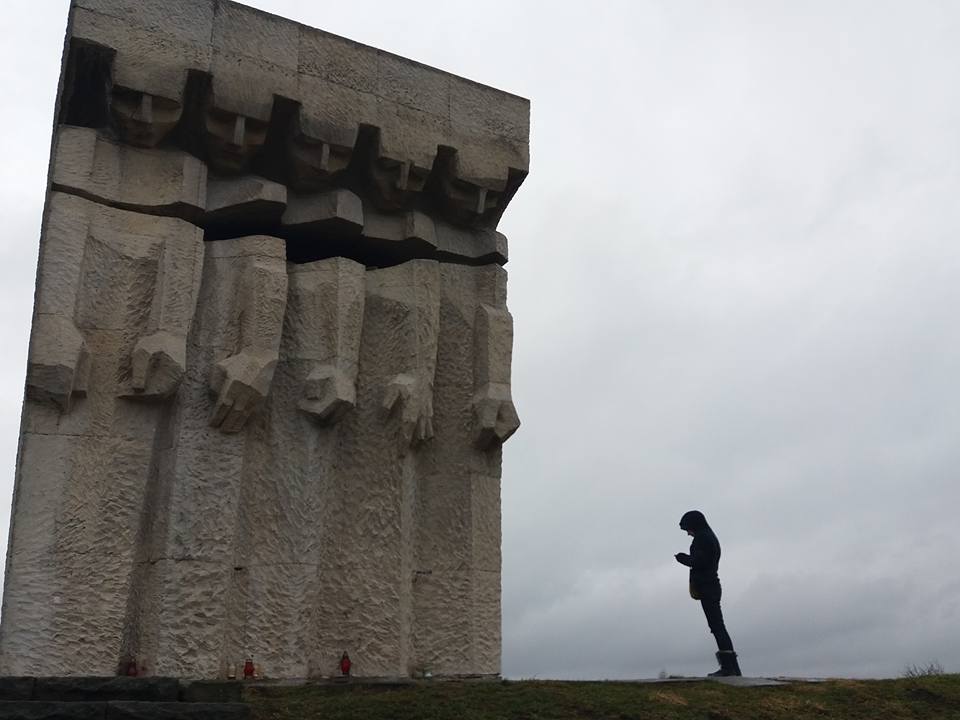
Plaszow concentration camp
Very little remains of the camp but I still recommend a visit. Any place where terrible things have happened seems to absorb the sadness and pain and ensures a visit is a sombre experience. Map.
Rainbow Stairs
OK, there’s nothing really here apart from some painted stairs with some Polish writing on them. But it is in an area that you probably wouldn’t come across otherwise. This is for people who have A LOT of time in Krakow. As the saying goes, “it’s not about the destination, it’s about the journey”. Map.
Rynek Square
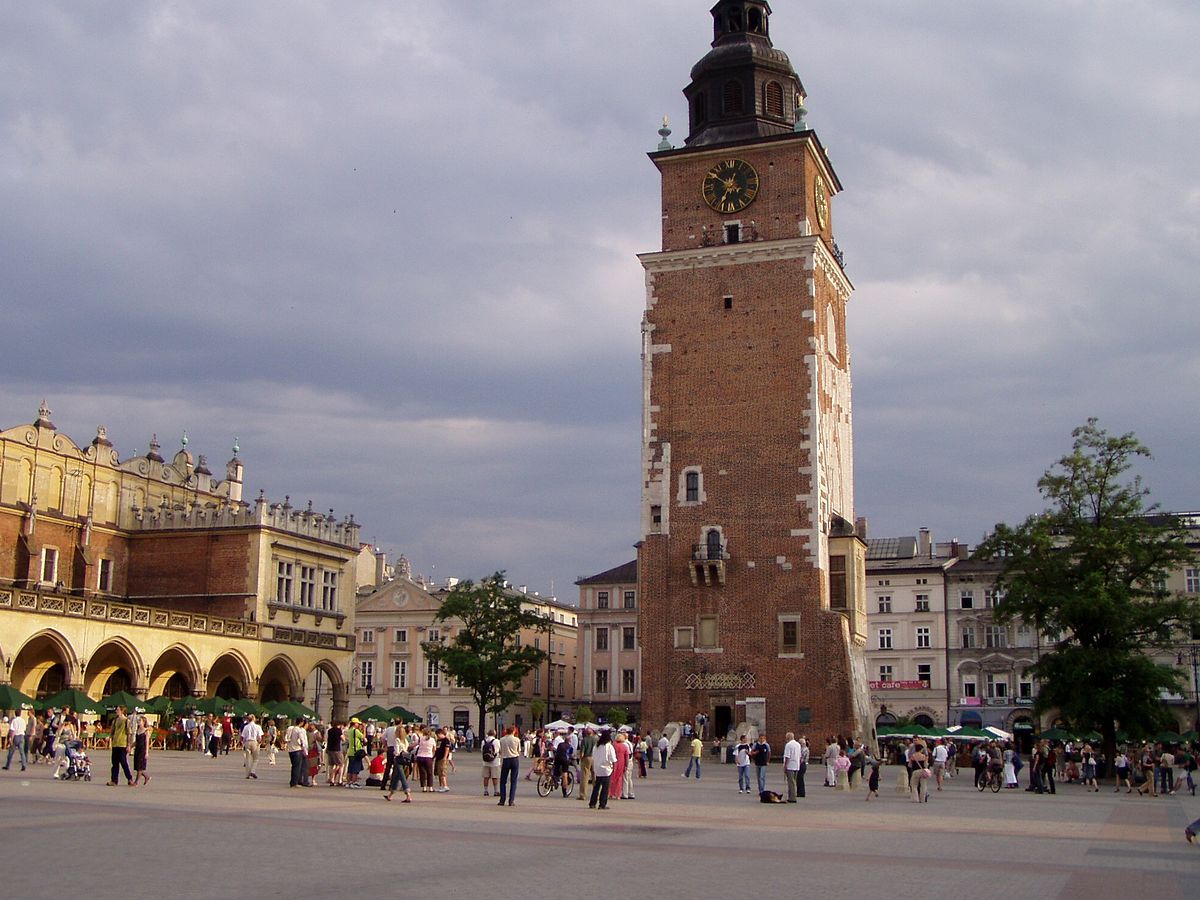
Kraków market square (rynek) with town hall tower and cloth halls, July 2005. This file is licensed under the Creative Commons Attribution-Share Alike 2.5 Generic license.
Krakow’s central marketplace is one of the largest Medieval squares in Europe. The Cloth Hall and St Mary’s Basilica are located within its 200 x 200 metre area. At Christmas, be sure to visit the Christmas market where you can enjoy mulled wines, pierogi, golonka and other tasty treats.
Stare Miastro
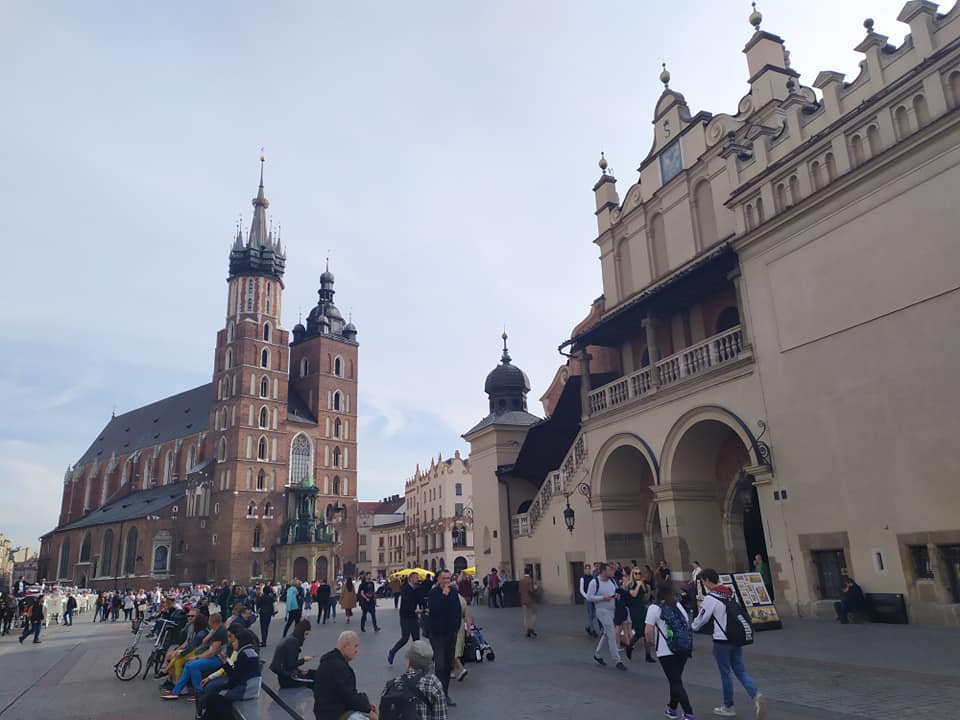
Rynek Square
‘Stare Miastro’ (map) is the old town in Krakow. It is filled with traditional Polish restaurants, souvenirs and bars. Wawel Royal Castle overlooks Rynek Square where you can find St Mary’s Basilica and, at its heart, Sukienicce (cloth hall), a 13th century market arcade. It is very beautiful, particularly in the evening.
Wawel Castle
The imposing presence of ‘Wawel Castle’ can be felt all over the city of Krakow. The UNESCO-listed castle sits, alongside the cathedral high above the old town. Try to visit the dragon that breathes fire and startles tourists!

By Ingo Mehling – Own work, CC BY-SA 4.0, https://commons.wikimedia.org/w/index.php?curid=84684080
Click here for information on visiting hours and ticket price.
Wieliczka Salt Mine
All around Krakow, you will see tour agencies selling package deals to the city’s two biggest tourist attractions: Auschwitz and Wieliczka Salt Mine. The only advantage I can see to booking a visit to the salt mine through an agency is that you will probably get a guaranteed time of visit.
We decided to make our own way there. From Krakow, you can take a direct bus to the salt mines. There are ticket machines on the bus. Not all machines accept card so it is a good idea to have some cash. Make sure you validate your ticket as the inspectors are notoriously unforgiving to tourists.
It took us around 40 minutes to reach the salt mine. The next available English tour was already full so we had to book on the next one, about 45 minutes later. This gave us time to visit the nearby ‘Tężnia Solankowa’. This is a tower that releases salt spray as inhalation therapy. Admission is not included with the salt mine ticket but it is cheap and worth a look if you have to wait for your salt mine tour.
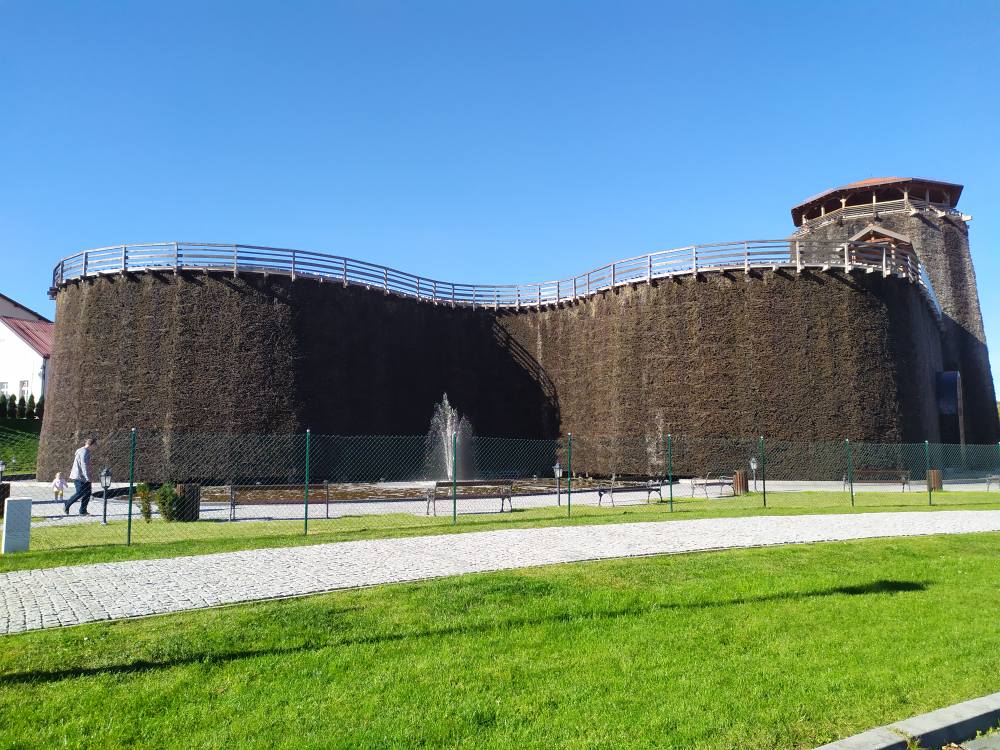
Tężnia Solankowa
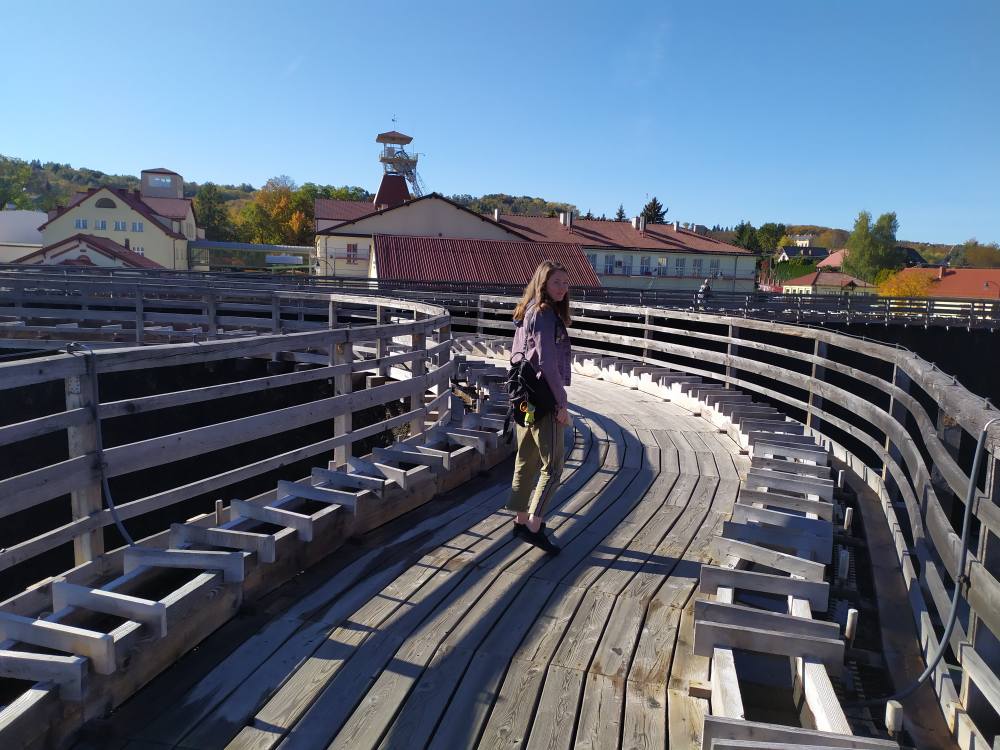
Joanna taking in the salt spray
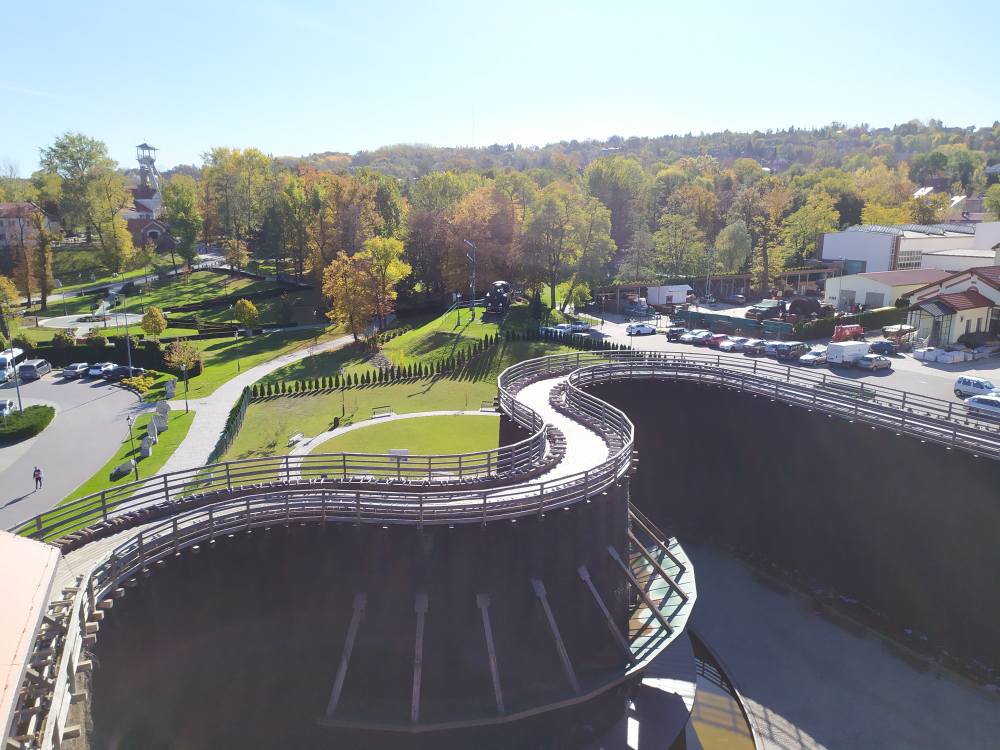
View from Tężnia Solankowa
Once in the salt mine, we met with our guide and began the 50 floor descent to the first level. We walked through the tunnels as our guide explained the history and gave us stories about the mine. He was very humorous and VERY knowledgeable about salt! Along the way, we could taste the salt from the walls and enjoy the many salt sculpures.
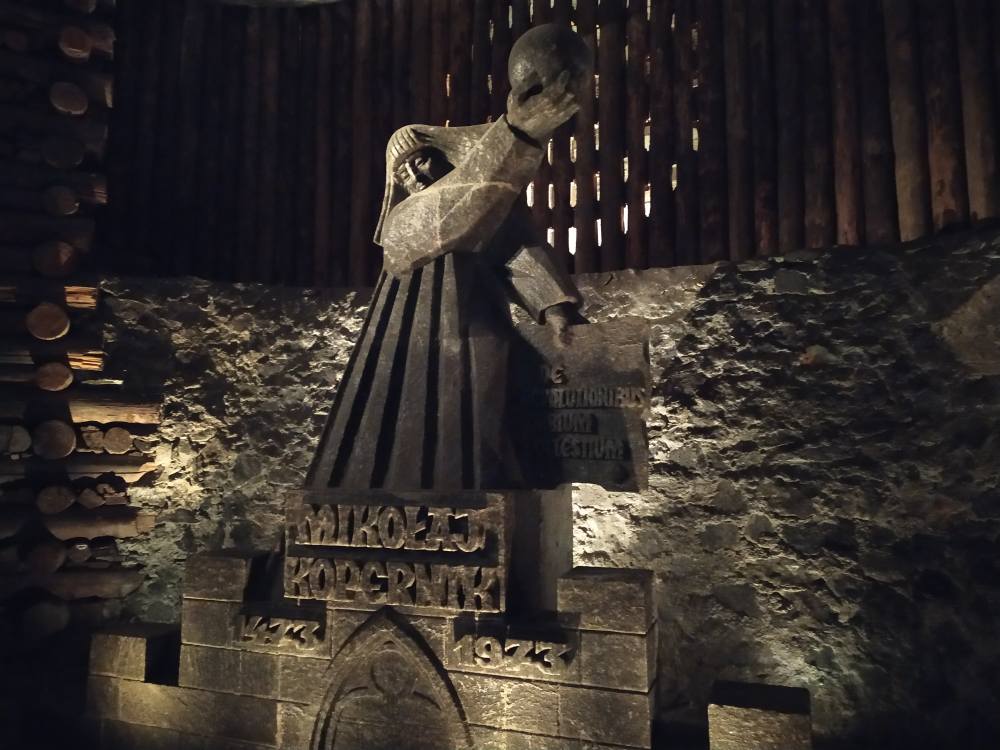
Salt sculpture
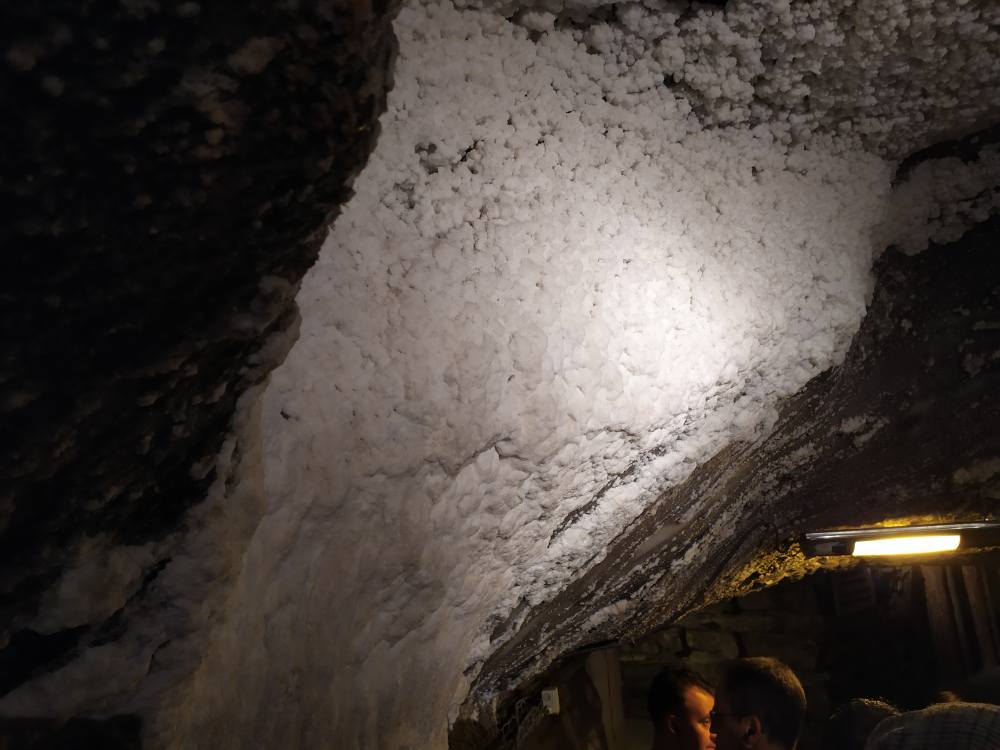
Needs chips
We then headed down to the second level. After many more sculptures and places of worship, we came to the highlight of the tour: the underground chapel.
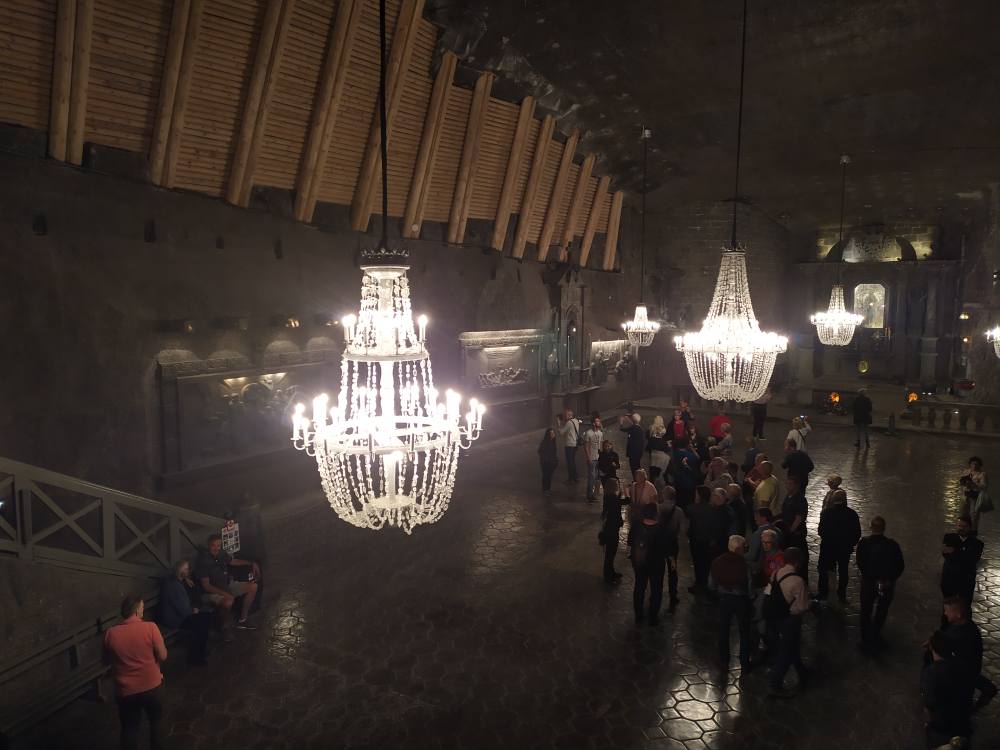
Underground chapel
Everything in the chapel is carved from salt, even the chandeliers. This chamber hosts weddings, classical concerts and new year parties. On the surrounding walls are many salt carvings.
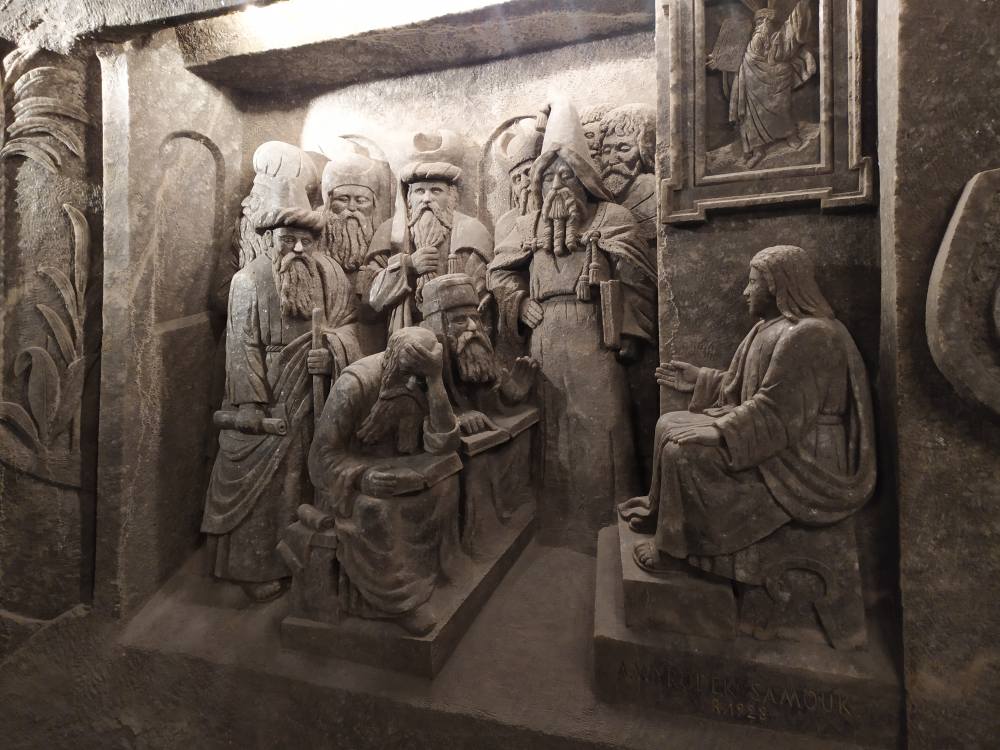
Salt carvings
Our guide then took us down to level 3, 130 metres underground.
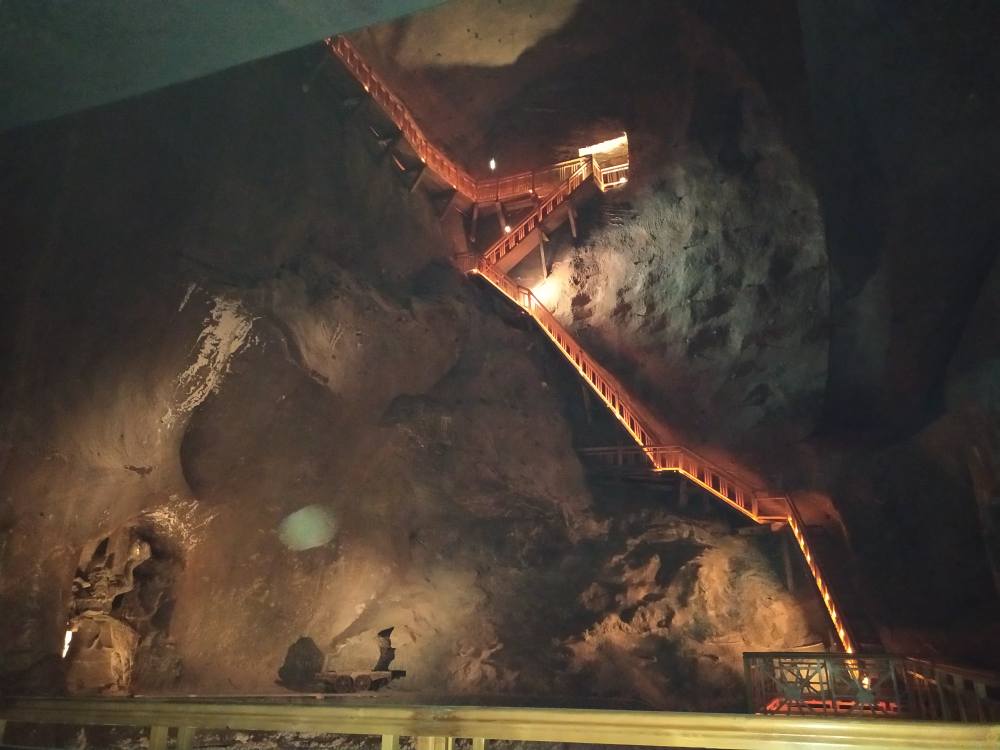
Level 3
The tour was coming to an end. There is a bar and a restaurant where you can enjoy a beer and a traditional Polish meal, 130 metres underground!
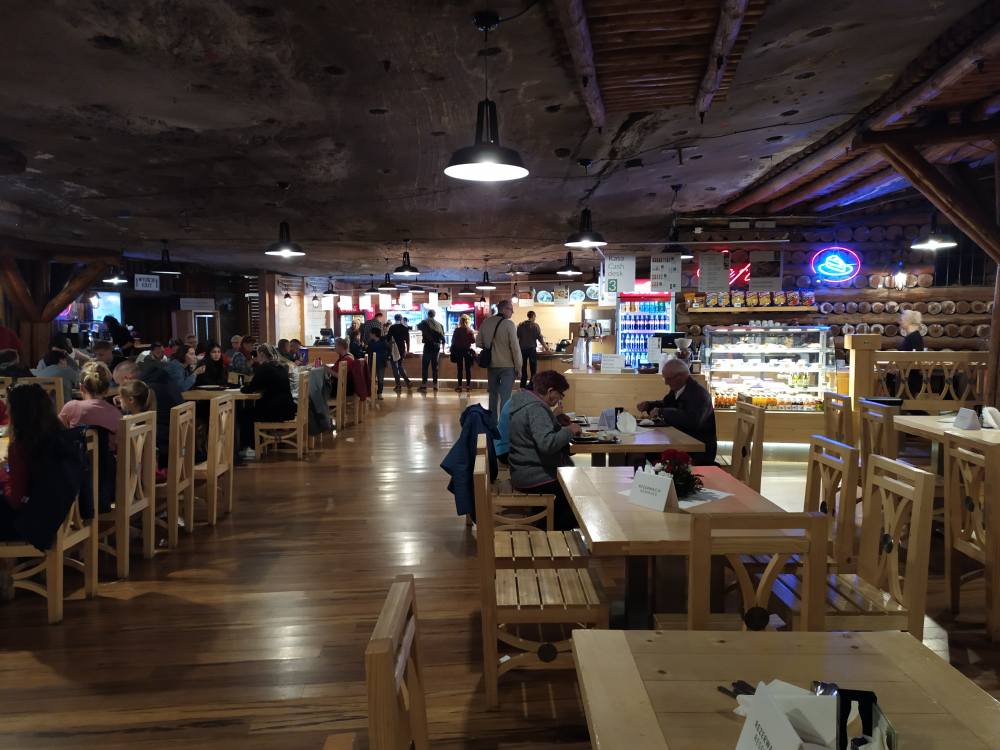
Underground restaurant
The salt mines were a great experience, made even better by our excellent guide. It is one of Krakow’s most popular tourist attractions for a reason.
Wieliczka Salt Mine Opening Times: 8 am – 5 pm, every day.
Wieliczka Salt Mine Entrance Fee: 66 PLN.
For more info: https://www.kopalnia.pl/
For more information about Krakow, visit https://visitkrakow.com/

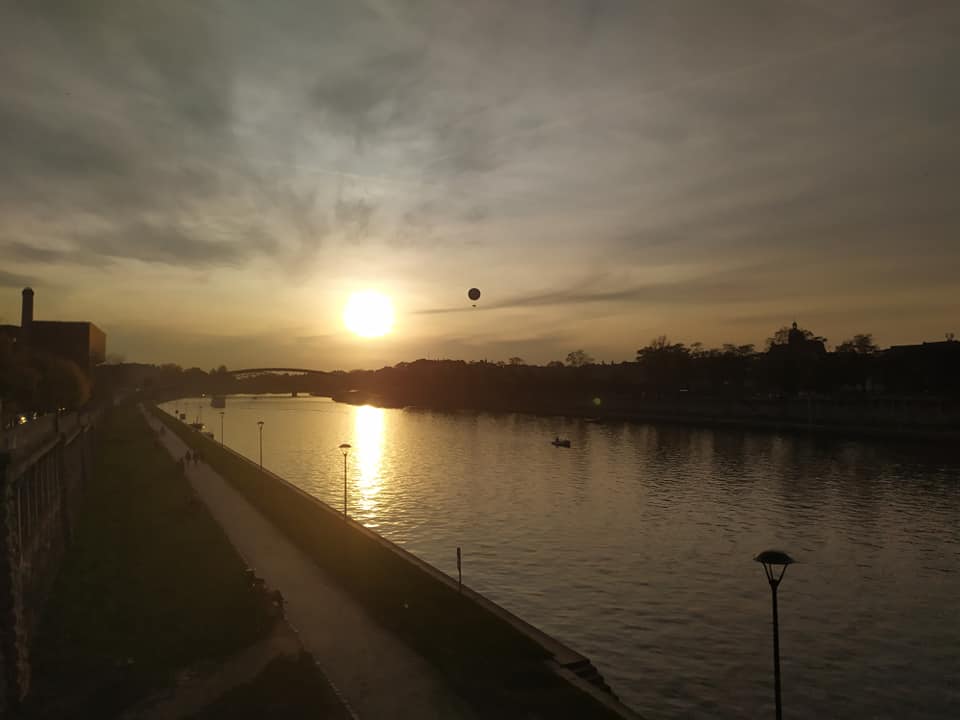
Pingback: Food And Drink In Krakow : Budget Travel in Poland - Global Treats
Pingback: Visit Auschwitz: Budget Travel in Poland - Global Treats
Pingback: Visit Katowice : Budget Travel in Poland - Global Treats